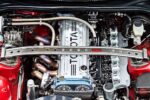The 2006 Jeep Grand Cherokee with the 3.7-liter engine has been a popular choice among SUV enthusiasts for its ruggedness and off-road capabilities. However, like any vehicle, it has its share of issues that can frustrate owners. Understanding the symptoms of these engine problems is essential for maintaining the vehicle’s performance and longevity.
Common Symptoms of Engine Problems
When it comes to the 3.7-liter engine, several signs can indicate that something’s not right. Recognizing these symptoms early can save you from more significant headaches down the road.
Performance Issues
One of the first things you might notice is a decline in performance. This can manifest in various ways:
- Loss of Power: The engine may struggle to accelerate, especially when going uphill or when loaded.
- Rough Idling: If the engine shakes or vibrates while idling, it could indicate a problem.
- Stalling: The engine may unexpectedly shut off, particularly at low speeds or when coming to a stop.
Unusual Noises
Sounds can often be the first clue that something is amiss. Pay attention to any new or unusual noises coming from the engine bay:
- Knocking or Tapping: This could suggest issues with the engine’s internals, such as worn bearings or a failing timing chain.
- Hissing or Whining: These sounds might indicate a vacuum leak or a problem with the serpentine belt.
Fluid Leaks
Fluid leaks can be a significant indicator of engine trouble. Keep an eye out for:
- Oil Leaks: Dark spots under the vehicle can signal an oil leak, which can lead to severe engine damage if not addressed.
- Coolant Leaks: A sweet smell or greenish fluid under the vehicle could mean a coolant leak, leading to overheating.
Warning Lights
The dashboard warning lights are there for a reason. If the check engine light comes on, it’s a clear signal that you should investigate further. Other lights, such as the oil pressure or temperature warning lights, should also not be ignored.
Fuel Economy Issues
If you notice that you’re filling up more often than usual, it could be a sign of engine problems. Poor fuel economy can result from various issues, including:
- Faulty fuel injectors
- Dirty air filters
- Malfunctioning sensors
Exhaust Issues
Finally, pay attention to the exhaust. If you see excessive smoke or notice a strong smell, it could indicate serious engine problems:
- Blue Smoke: This often means oil is burning in the combustion chamber.
- Black Smoke: This can indicate a rich fuel mixture, often due to a faulty sensor.
Understanding these symptoms can help you diagnose potential issues with the 3.7-liter engine in your 2006 Jeep Grand Cherokee. Being proactive about these signs will not only enhance your driving experience but also extend the life of your vehicle.
Understanding Engine Problems in the 2006 Jeep Grand Cherokee
The 2006 Jeep Grand Cherokee with the 3.7-liter engine has garnered mixed reviews from owners, particularly regarding its engine reliability. While some drivers appreciate its performance, many have reported various issues that can lead to frustration and costly repairs. This section delves into the common causes of engine problems and shares insights from owners who have experienced these issues firsthand.
Common Causes of Engine Problems
Several factors can contribute to the engine problems seen in the 3.7-liter engine. Understanding these causes can help you identify potential issues before they escalate.
| Problem | Possible Causes | Symptoms |
|---|---|---|
| Oil Leaks | Worn gaskets, damaged seals | Oil spots under the vehicle, low oil levels |
| Overheating | Coolant leaks, faulty thermostat | Temperature gauge in the red, steam from the engine |
| Rough Idling | Dirty fuel injectors, vacuum leaks | Engine shakes, fluctuating RPMs |
| Stalling | Fuel delivery issues, electrical problems | Engine shuts off unexpectedly, difficulty restarting |
| Poor Fuel Economy | Clogged air filters, malfunctioning sensors | Frequent trips to the gas station, decreased mileage |
Owner Opinions on Engine Issues
Many owners of the 2006 Jeep Grand Cherokee with the 3.7-liter engine have taken to online forums to share their experiences. Here’s a summary of their insights:
- Frequent Oil Changes: Some owners have noted that the engine seems to consume oil more rapidly than expected. They recommend checking oil levels regularly and changing the oil frequently to avoid damage.
- Overheating Problems: A common complaint is overheating, particularly during hot weather or when towing. Many users have attributed this to a faulty thermostat or radiator issues.
- Rough Idle and Stalling: Several drivers have reported rough idling and stalling, especially at low speeds. Many believe that cleaning the fuel injectors or replacing the spark plugs can help alleviate these issues.
- Electrical Gremlins: Some owners have experienced electrical problems that lead to stalling or difficulty starting the engine. They suggest having the battery and alternator checked regularly.
- Fuel Economy Concerns: Many have expressed frustration over poor fuel economy, often linking it to dirty air filters or malfunctioning sensors. Regular maintenance is often cited as a way to improve mileage.
Conclusion of Owner Experiences
While the 2006 Jeep Grand Cherokee 3.7-liter engine has its share of problems, it’s crucial to stay informed about the potential issues and their causes. Many owners emphasize the importance of regular maintenance and being proactive about any symptoms that arise. By doing so, you can help ensure that your Grand Cherokee remains a reliable vehicle for years to come.
Recalls and Technical Service Bulletins for the 2006 Jeep Grand Cherokee
The 2006 Jeep Grand Cherokee with the 3.7-liter engine has been subject to various recalls and Technical Service Bulletins (TSBs) over the years. These documents are crucial for addressing known issues and ensuring the safety and reliability of the vehicle. Understanding these recalls and TSBs can provide valuable insight into common problems faced by owners.
Recalls
Recalls are issued when a manufacturer identifies a safety defect or non-compliance with federal regulations. For the 2006 Jeep Grand Cherokee, a few notable recalls have been documented:
- Recall for Fuel Pump: In some cases, the fuel pump may fail, leading to engine stalling. This recall was initiated to replace the faulty fuel pumps to prevent potential accidents.
- Recall for Ignition Switch: A faulty ignition switch could cause the engine to shut off unexpectedly, increasing the risk of a crash. This recall involved replacing the ignition switch to ensure proper functionality.
Technical Service Bulletins (TSBs)
TSBs are issued by manufacturers to inform dealerships and repair facilities about common issues and recommended fixes. For the 2006 Jeep Grand Cherokee, several TSBs have been released that address engine-related problems:
| TSB Number | Issue | Description |
|---|---|---|
| 18-001-06 | Engine Stalling | This bulletin addresses engine stalling issues that may occur due to a faulty throttle body. It includes instructions for inspection and replacement. |
| 18-002-06 | Rough Idle | This TSB provides guidance on diagnosing rough idle complaints and suggests cleaning the throttle body and idle air control valve as potential solutions. |
| 18-003-06 | Oil Consumption | This bulletin discusses excessive oil consumption issues and recommends checking for leaks and proper maintenance practices. |
Importance of Recalls and TSBs
Staying informed about recalls and TSBs is vital for any vehicle owner. Here’s why:
- Safety: Recalls often address safety-related defects that could pose a risk to drivers and passengers.
- Preventive Maintenance: TSBs provide valuable information on common issues, helping owners and mechanics address problems before they escalate.
- Increased Resale Value: Addressing recalls and following TSB recommendations can enhance the vehicle’s reliability and resale value.
By keeping track of recalls and TSBs, owners of the 2006 Jeep Grand Cherokee can take proactive steps to mitigate engine problems and ensure a safer driving experience.
Or open the survey in a new tab: Take the Survey




0 Comments